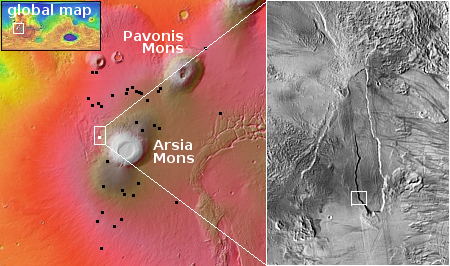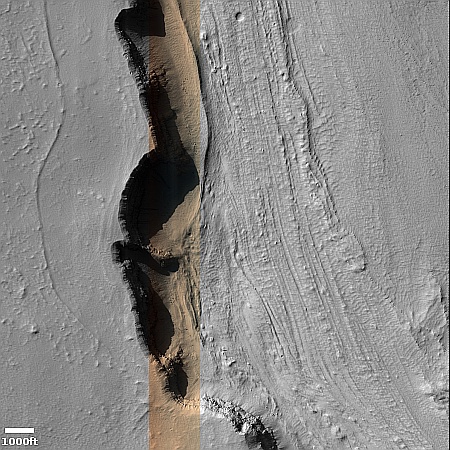Mars will be mystery until we can walk its surface
Today’s cool image illustrates starkly the limitations of orbital imagery. The picture to the right, rotated, cropped, reduced, and sharpened to post here, was taken on March 30, 2025 by the high resolution camera on Mars Reconnaissance Orbiter (MRO). It shows flow features inside a depression that strongly resemble glacial features, with the downhill grade roughly heading south.
Such features are seen in many places on Mars, almost always in the 30 to 60 degree mid-latitude bands in both the northern and southern hemispheres (see here, here, and here for just three examples. For many more simply search this website using “glacier” or “glacial feature” as search terms).
The problem is that this location is not within that 30 to 60 degree latitude band. In fact, at this location no near surface ice should exist at all.

The white dot on the overview map to the right marks the location, inside a 45-mile-long depression about a thousand feet deep that sits on the northwestern slopes of the giant volcano Arsia Mons. The black dots mark the locations of the many cave pits that have so far been located in this region.
The latitude here is 7.5 degrees south, placing this deep inside the dry equatorial region of Mars, where no near surface ice has been found.
So is this a major discovery of glaciers on the high slopes of Arsia? Maybe. Early orbital data had found evidence of past glacial activity on Arsia Mons, especially on its western slopes. Furthermore, a seasonal long cloud forms each spring and summer over Arsia, flowing westward, that some suggest could be water ice sublimating away from leftover underground ice deposits from that past glacial activity.
Or maybe not. We might simply be looking at frozen Martian lava deposited in this depression when Arsia Mons was an active volcano. The parallel lines might be indicating multiple eruptions laid down one after another on top of each other. It is also possible that Martian lava flows mimic some glacial features once frozen.
So is this frozen lava or near surface ice? Orbital data not available to me might clarify this question, but I guarantee it will not answer it definitively. The only way we can know for certain is to go there, walk the surface, and take samples. A robotic rover or helicopter might do it, but it would do so slowly and with some uncertainty.
Put a person there with a rock hammer and the question would be answered in just a few hours.
On Christmas Eve 1968 three Americans became the first humans to visit another world. What they did to celebrate was unexpected and profound, and will be remembered throughout all human history. Genesis: the Story of Apollo 8, Robert Zimmerman's classic history of humanity's first journey to another world, tells that story, and it is now available as both an ebook and an audiobook, both with a foreword by Valerie Anders and a new introduction by Robert Zimmerman.
The print edition can be purchased at Amazon or from any other book seller. If you want an autographed copy the price is $60 for the hardback and $45 for the paperback, plus $8 shipping for each. Go here for purchasing details. The ebook is available everywhere for $5.99 (before discount) at amazon, or direct from my ebook publisher, ebookit. If you buy it from ebookit you don't support the big tech companies and the author gets a bigger cut much sooner.
The audiobook is also available at all these vendors, and is also free with a 30-day trial membership to Audible.
"Not simply about one mission, [Genesis] is also the history of America's quest for the moon... Zimmerman has done a masterful job of tying disparate events together into a solid account of one of America's greatest human triumphs."--San Antonio Express-News
Today’s cool image illustrates starkly the limitations of orbital imagery. The picture to the right, rotated, cropped, reduced, and sharpened to post here, was taken on March 30, 2025 by the high resolution camera on Mars Reconnaissance Orbiter (MRO). It shows flow features inside a depression that strongly resemble glacial features, with the downhill grade roughly heading south.
Such features are seen in many places on Mars, almost always in the 30 to 60 degree mid-latitude bands in both the northern and southern hemispheres (see here, here, and here for just three examples. For many more simply search this website using “glacier” or “glacial feature” as search terms).
The problem is that this location is not within that 30 to 60 degree latitude band. In fact, at this location no near surface ice should exist at all.

The white dot on the overview map to the right marks the location, inside a 45-mile-long depression about a thousand feet deep that sits on the northwestern slopes of the giant volcano Arsia Mons. The black dots mark the locations of the many cave pits that have so far been located in this region.
The latitude here is 7.5 degrees south, placing this deep inside the dry equatorial region of Mars, where no near surface ice has been found.
So is this a major discovery of glaciers on the high slopes of Arsia? Maybe. Early orbital data had found evidence of past glacial activity on Arsia Mons, especially on its western slopes. Furthermore, a seasonal long cloud forms each spring and summer over Arsia, flowing westward, that some suggest could be water ice sublimating away from leftover underground ice deposits from that past glacial activity.
Or maybe not. We might simply be looking at frozen Martian lava deposited in this depression when Arsia Mons was an active volcano. The parallel lines might be indicating multiple eruptions laid down one after another on top of each other. It is also possible that Martian lava flows mimic some glacial features once frozen.
So is this frozen lava or near surface ice? Orbital data not available to me might clarify this question, but I guarantee it will not answer it definitively. The only way we can know for certain is to go there, walk the surface, and take samples. A robotic rover or helicopter might do it, but it would do so slowly and with some uncertainty.
Put a person there with a rock hammer and the question would be answered in just a few hours.
On Christmas Eve 1968 three Americans became the first humans to visit another world. What they did to celebrate was unexpected and profound, and will be remembered throughout all human history. Genesis: the Story of Apollo 8, Robert Zimmerman's classic history of humanity's first journey to another world, tells that story, and it is now available as both an ebook and an audiobook, both with a foreword by Valerie Anders and a new introduction by Robert Zimmerman.
The print edition can be purchased at Amazon or from any other book seller. If you want an autographed copy the price is $60 for the hardback and $45 for the paperback, plus $8 shipping for each. Go here for purchasing details. The ebook is available everywhere for $5.99 (before discount) at amazon, or direct from my ebook publisher, ebookit. If you buy it from ebookit you don't support the big tech companies and the author gets a bigger cut much sooner.
The audiobook is also available at all these vendors, and is also free with a 30-day trial membership to Audible.
"Not simply about one mission, [Genesis] is also the history of America's quest for the moon... Zimmerman has done a masterful job of tying disparate events together into a solid account of one of America's greatest human triumphs."--San Antonio Express-News



“”In fact, at this location no near surface ice should exist at all.””
One of my favorite phrases from Robert Zimmerman: The uncertainty of science.
The real scientific method was taught to me many, many moons ago. Some of my best teachers & professors would say: (this) we know; (this other thing) is a maybe; and finally – we have no idea, for many things.
Perhaps the real ‘consensus’ in science should be – What the Hell is That?
There’s an unusual amount of “slope streaks”, especially in the shaded areas.
I wish we had better visibility on the dark crack that appears to be a vent?